Similar presentations:
Anatomy of nervous system
1.
ANATOMY & PHYSIOLOGYChapter 13 ANATOMY OF NERVOUS SYSTEM
PowerPoint Image Slideshow
N.B.: Exercises 14 and 15 of
your lab manual are mandatory
complements for this chapter.
2. MAJOR CHAPTER Objectives
MAJOR CHAPTER OBJECTIVES• Relate the developmental processes of the embryonic nervous
system to the adult structures
• Name the major regions of the adult nervous system
• Locate regions of the cerebral cortex on the basis of anatomical
landmarks common to all human brains
• Describe the regions of the spinal cord in cross-section
• List the cranial nerves in order of anatomical location and provide
the central and peripheral connections
• List the spinal nerves by vertebral region and by which nerve
plexus each supplies
Add:
• Explain and illustrate the concept of somatotopy (associated to that
of “localization of function”)
• Be able to discuss normal development and selected aging issues
• Be able to discuss selected, associated disorders
3. 13.1 The Embryologic Perspective Major section Objectives
13.1 THE EMBRYOLOGIC PERSPECTIVEMAJOR SECTION OBJECTIVES
• Describe the growth and differentiation of the neural tube
• Relate the different stages of development to the adult structures
of the central nervous system
• Explain the expansion of the ventricular system of the adult brain
from the central canal of the neural tube
• Describe the connections of the diencephalon and cerebellum on
the basis of patterns of embryonic development
4. Figure 13.2
FIGURE 13.2Early Embryonic Development of Nervous System (at about 16 days)
The neuroectoderm begins to fold inward to form the neural groove. As the two sides of
the neural groove converge, they form the neural tube, which lies beneath the
ectoderm. The anterior end of the neural tube will develop into the brain, and the
posterior portion will become the spinal cord. The neural crest develops into peripheral
structures.
5. Figure 13.3
FIGURE 13.3Primary and Secondary Vesicle Stages of Development
The embryonic brain develops complexity through enlargements of the neural tube
called vesicles; (a) The primary vesicle stage has three regions, and (b) the secondary
vesicle stage has five regions.
6. Figure 13.4
FIGURE 13.4Human Neuraxis
The mammalian nervous system is arranged with the neural tube running along an anterior to
posterior axis, from nose to tail for a four-legged animal like a dog. Humans, as two-legged
animals, have a bend in the neuraxis between the brain stem and the diencephalon, along
with a bend in the neck, so that the eyes and the face are oriented forward.
7. table 13.1
TABLE 13.1Stages of Embryonic Development
Neural
tube
Primary
vesicle stage
Secondary
vesicle stage
Adult
structures
Ventricles
Anterior
Prosencephalon
Telencephalon
Cerebrum
Lateral
ventricles
(I and II)
Anterior
Prosencephalon
Diencephalon
Diencephalon
Third - III
Anterior
Mesencephalon
Mesencephalon
Midbrain
Cerebral
aqueduct
Anterior
Rhombencephalon
Metencephalon
Pons,
cerebellum
Fourth - IV
Anterior
Rhombencephalon
Myelencephalon
Medulla
Fourth - IV
Posterior
-
-
Spinal cord
Central
canal
N.B. A synonym for “cerebral aqueduct” is “aqueduct of Sylvius”.
8. 13.2 The Central Nervous System Major section Objectives
13.2 THE CENTRAL NERVOUS SYSTEMMAJOR SECTION OBJECTIVES
• Name the major regions of the adult brain
• Describe the connections between the cerebrum and brain stem
through the diencephalon, and from those regions into the spinal
cord
• Recognize the complex connections within the subcortical structures
of the basal nuclei
• Explain the arrangement of gray and white matter in the spinal cord
9. Figure 13.6
FIGURE 13.6The Cerebrum
The cerebrum is a large component of the CNS in humans, and the most obvious
aspect of it is the folded surface called the cerebral cortex.
10. Figure 13.7
FIGURE 13.7Lobes of the Cerebral Cortex
The cerebral cortex is divided into
four five lobes. Extensive folding
increases the surface area
available for cerebral functions.
Omisson in text and figures:
The cerebrum is divided in five
lobes: frontal, parietal, temporal,
occipital and the insula, buried
within the temporal lobe on each
side.
11. Figure 13.8
FIGURE 13.8Add
Brodmann’s Areas of the Cerebral Cortex
Brodmann mapping of functionally distinct regions of the cortex was based on its
cytoarchitecture at a microscopic level.
12. Figure 13.9
FIGURE 13.9Frontal Section of Cerebral Cortex and Basal
Nuclei
The major components of the basal nuclei, shown in a
frontal section of the brain, are the caudate (just lateral
to the lateral ventricle), the putamen (inferior to the
caudate and separated by the large white-matter
structure called the internal capsule), and the globus
pallidus (medial to the putamen).
BIO229: You are
expected to learn to
name and recognize
the basal nuclei and
explain their general
functions, but NOT
expected to memorize
the details found below
Fig. 13.9, on p. 562 of
your textbook, or in
Fig. 13.10.
13. Figure 13.11
FIGURE 13.11Add
Epithalamus
The Diencephalon
The diencephalon is composed primarily of the thalamus and hypothalamus, which
together define the walls of the third ventricle. The thalami are two elongated, ovoid
structures on either side of the midline that make contact in the middle. The
hypothalamus is inferior and anterior to the thalamus, culminating in a sharp angle to
which the pituitary gland is attached.
Add: The epithalamus contains, mostly, the pineal gland.
14. Figure 13.12
FIGURE 13.12The Brain Stem
The brain stem comprises three regions: the midbrain, the pons, and the medulla.
15. Figure 13.13
FIGURE 13.13The Cerebellum
The cerebellum is situated on the
posterior surface of the brain stem.
Descending input from the cerebellum
enters through the large white matter
structure of the pons. Ascending input
from the periphery and spinal cord enters
through the fibers of the inferior olive.
Output goes to the midbrain, which
sends a descending signal to the spinal
cord.
16. Figure 13.14
FIGURE 13.14Cross-section of Spinal Cord
The cross-section of a thoracic spinal
cord segment shows the posterior,
anterior, and lateral horns of gray matter,
as well as the posterior, anterior, and
lateral columns of white matter. LM × 40.
(Micrograph provided by the Regents of
University of Michigan Medical School ©
2012)
N.B. Each white column can
also be called a “funiculus”
(plural: funiculi).
17. 13.3 Circulation in the Central Nervous System Major section Objectives
13.3 CIRCULATION IN THE CENTRAL NERVOUS SYSTEMMAJOR SECTION OBJECTIVES
• Describe the vessels that supply the CNS with blood
• Name the components of the ventricular system and the regions of
the brain in which each is located
• Explain the production of cerebrospinal fluid and its flow through the
ventricles
• Explain how a disruption in circulation would result in a stroke
18. Figure 13.15
FIGURE 13.15Circle of Willis
The blood supply to the brain enters
through the internal carotid arteries
and the vertebral arteries,
eventually giving rise to the circle of
Willis.
19. Figure 13.16
FIGURE 13.16Dural Sinuses and Veins
Blood drains from the brain through a
series of sinuses that connect to the
jugular veins.
20. Figure 13.17
FIGURE 13.17Meningeal Layers of Superior Sagittal Sinus
The layers of the meninges in the longitudinal fissure of the superior sagittal sinus are
shown, with the dura mater adjacent to the inner surface of the cranium, the pia mater
adjacent to the surface of the brain, and the arachnoid and subarachnoid space
between them. An arachnoid villus is shown emerging into the dural sinus to allow CSF
to filter back into the blood for drainage.
21. Figure 13.18
FIGURE 13.18Cerebrospinal Fluid Circulation
The choroid plexus in the four ventricles produce CSF, which is circulated through the
ventricular system and then enters the subarachnoid space through the median and lateral
apertures. The CSF is then reabsorbed into the blood at the arachnoid granulations, where
the arachnoid membrane emerges into the dural sinuses.
22. Modified table 13.2
MODIFIED TABLE 13.2Components of CSF Circulation
Component
Location in CNS
Blood vessel structure
Lateral ventricle – I
Cerebrum, left hemisphere
Choroid plexus
Lateral ventricle – II
Cerebrum, right hemisphere
Choroid plexus
Third ventricle – III
Diencephalon
Choroid plexus
Cerebral aqueduct
Midbrain
None
Fourth ventricle – IV
Between pons, upper medulla
and cerebellum
Choroid plexus
Central canal
Spinal cord
None
Subarachnoid space
External to the entire CNS
Arachnoid granulations
projecting into dural
sinuses
23. 13.4 The Peripheral Nervous System Major section Objectives
13.4 THE PERIPHERAL NERVOUS SYSTEMMAJOR SECTION OBJECTIVES
• Describe the structures found in the PNS
• Distinguish between somatic and autonomic structures, including the
special peripheral structures of the enteric nervous system
• Name the twelve cranial nerves and explain the functions associated
with each
• Describe the sensory and motor components of spinal nerves and
the plexuses that they pass through
24. Figure 13.19
FIGURE 13.19Dorsal Root Ganglion
The cell bodies of sensory neurons, which are unipolar neurons by shape, are seen in
this photomicrograph. Also, the fibrous region is composed of the axons of these
neurons that are passing through the ganglion to be part of the dorsal nerve root (tissue
source: canine). LM × 40. (Micrograph provided by the Regents of University of
Michigan Medical School © 2012)
25. Figure 13.20
FIGURE 13.20Spinal Cord and Root Ganglion
The slide includes both a cross-section of the lumbar spinal cord and a section of the
dorsal root ganglion (see also Figure 13.19) (tissue source: canine). LM × 1600.
(Micrograph provided by the Regents of University of Michigan Medical School © 2012)
26. Figure 13.21
FIGURE 13.21Nerve Structure
The structure of a nerve is
organized by the layers of
connective tissue on the
outside, around each
fascicle, and surrounding
the individual nerve fibers
(tissue source: simian).
LM × 40. (Micrograph
provided by the Regents
of University of Michigan
Medical School © 2012)
27. Figure 13.22
FIGURE 13.22Close-Up of Nerve Trunk
Zoom in on this slide of a nerve trunk to examine the endoneurium, perineurium, and
epineurium in greater detail (tissue source: simian). LM × 1600. (Micrograph provided
by the Regents of University of Michigan Medical School © 2012)
28. Figure 13.23
FIGURE 13.23The Cranial Nerves
The anatomical arrangement of the roots of the cranial nerves observed from an inferior
view of the brain.
29. Modified table 13.3
MODIFIED TABLE 13.3Cranial Nerves
#
Name(s)
Function (S/M/B)
Peripheral connection
I
Olfactory
Smell (S)
Olfactory epithelium
II
Optic
Vision (S)
Retina
III
Oculomotor
Eye mvmnts (M)
Orbit, eye muscles
IV
Trochlear
Eye mvmnts (M)
Superior oblique m.
V
Trigeminal
Sensory/Motor face (B)
Many in V1, V2, V3
VI
Abducens
Eye mvmnts (M)
Lateral rectus m.
VII
Facial
Motor face, taste (B)
Facial muscles, ganglia
VIII
Vestibulochoclear
(Auditory)
Hearing and Balance (S)
Spiral ganglion
Vestibular ganglion
IX
Glossopharyngeal
Motor throat, taste (B)
Pharynx muscles, ganglia
X
Vagus
Sensory/Motor viscera (B)
Ganglia (thorax, abdomen)
XI
Accessory (Spinal)
Motor head/neck (M)
Neck muscles
XII
Hypoglossal
Motor lower throat (M)
Larynx, low pharynx
muscles
30. Figure 13.24
FIGURE 13.24Nerve Plexuses of the Body
There are four main nerve plexuses
in the human body. The cervical
plexus supplies nerves to the
posterior head and neck, as well as
to the diaphragm. The brachial
plexus supplies nerves to the arm.
The lumbar plexus supplies nerves
to the anterior leg. The sacral
plexus supplies nerves to the
posterior leg.
31. Typos
TYPOSN.B.
Nerves do not enervate targets!
To enervate means to make weak, tired…
Nerves innervate targets.
32. development
DEVELOPMENT• Embryonic Germ Layers - Review
• To begin, a sperm cell and an egg cell fuse to become a
fertilized egg. The fertilized egg cell, or zygote, starts
dividing to generate the cells that make up an entire
organism. Sixteen days after fertilization, the developing
embryo’s cells belong to one of three germ layers that give
rise to the different tissues in the body.
The endoderm, or inner tissue, is responsible for generating
the lining tissues of various spaces within the body, such as
the mucosae of the digestive and respiratory systems.
The mesoderm, or middle tissue, gives rise to most of the
muscle and connective tissues.
Finally the ectoderm, or outer tissue, develops into the
integumentary system (the skin) and the nervous system.
33. development
DEVELOPMENT• Neural Tube Formation
• Early formation of the nervous system depends on the
formation of the neural tube. A groove forms along the dorsal
surface of the embryo, which becomes deeper until its edges
meet and close off to form the tube. If this fails to happen,
especially in the posterior region where the spinal cord forms,
a developmental defect called spina bifida occurs. The closing
of the neural tube is important for more than just the proper
formation of the nervous system. The surrounding tissues are
dependent on the correct development of the tube. The
connective tissues surrounding the CNS can be involved as
well.
34. aging
AGING• Anosmia
• The sensory neurons of the olfactory epithelium have a
limited lifespan of approximately one to four months, and
new ones are made on a regular basis. The new neurons
extend their axons into the CNS by growing along the
existing fibers of the olfactory nerve.
• Anosmia is the loss of the sense of smell.
• Anosmia is often the result of the olfactory nerve being
severed, usually because of blunt force trauma to the head.
Following the damage, new neurons cannot regrow without
intact fibers to follow.
• The ability of these neurons to be replaced is also lost with
age. Age-related anosmia is hence a slow loss of the
sensory neurons responsible for olfaction, with no new
neurons born to replace them.
35. everyday connections
EVERYDAY CONNECTIONS• Left Brain/Right Brain
• To say that people are “right-brained” or “left-brained” is an
oversimplification of an important concept about the
cerebral hemispheres.
• There is some lateralization of function, in which the left
side of the brain is devoted to language function and the
right side is devoted to spatial and nonverbal reasoning in
most individuals.
• But whereas these functions are predominantly associated
with those sides of the brain, there is no monopoly by either
side on these functions. Many pervasive functions, such as
language, are distributed globally around the cerebrum.
• The term “cerebral dominance” is nonetheless still used to
describe the side of the cerebrum where the language of
Broca and Wernicke are found (nothing to do with being
right- or left-handed!).
36. disorders & homeostatic imbalances
DISORDERS & HOMEOSTATIC IMBALANCESSpina Bifida
Results from a failure of the neural tube to close.Two forms
present with an external cyst, this mass forming a “second head”
that gave this condition its name (bi-fida = two heads).
There are three classes of this disorder: occulta, meningocele,
and myelomeningocele.
Spina bifida occulta, is the mildest because the vertebral bones do
not fully surround the spinal cord, but the spinal cord itself is not
affected. No functional differences may be noticed, which is what
the word occulta means; it is hidden spina bifida.
The other two types both involve the formation of a cyst—a fluidfilled sac of the connective tissues that cover the spinal cord
called the meninges. Surgery to close the opening or to remove
the cyst is necessary; the earlier that it can be performed, the
better the chances of controlling or limiting further damage or
infection at the opening.
“Meningocele” means that the meninges protrude through the
spinal column but nerves may not be involved and few symptoms
are present, though complications may arise later in life.
“Myelomeningocele” means that the meninges protrude and spinal
nerves are involved, and therefore severe neurological symptoms
can be present.
37. Figure 13.5
FIGURE 13.5Spinal Bifida
(a) Spina bifida is a birth defect of the
spinal cord caused when the neural
tube does not completely close, but
the rest of development continues.
The result is the emergence of
meninges and neural tissue through
the vertebral column.
(b) Fetal myelomeningocele is evident in
this ultrasound taken at 21 weeks.
38. disorders & homeostatic imbalances
DISORDERS & HOMEOSTATIC IMBALANCES• Basal Nuclei and Parkinson’s Disease
• Parkinson’s disease is a disorder of the basal nuclei,
specifically of the substantia nigra. As the dopamineproducing neurons in the substantia nigra pars compacta die,
they fail to modulate the activity of the basal nuclei properly –
causing too much inhibition of cortical activity which results in
a hypokinetic disorder.
• Parkinson’s disease is neurodegenerative, meaning that
neurons die that cannot be replaced, so there is no cure for
the disorder.
• Treatments for Parkinson’s disease are aimed at increasing
dopamine levels among basal nuclei by providing the amino
acid L-DOPA, which is a precursor to the neurotransmitter
dopamine that can cross the blood-brain barrier (dopamine
cannot).
• Unfortunately, patients become less responsive to L-DOPA
treatment as time progresses - and the increased dopamine
levels created elsewhere in the brain can be associated with
psychosis or schizophrenia.
39. disorders & homeostatic imbalances
DISORDERS & HOMEOSTATIC IMBALANCESMeningitis
Meningitis is an inflammation of the meninges, the three layers of
fibrous membrane that surround the CNS, and can be caused by
infection by bacteria or viruses. The particular pathogens are not
special to meningitis.
Symptoms of meningitis include: fever, chills, nausea, vomiting,
light sensitivity, soreness of the neck, or severe headache, but
also changes in mental state (confusion, memory deficits, etc.).
The primary test for meningitis is a lumbar puncture.
Viral meningitis is usually the result of common enteroviruses
(such as those that cause intestinal disorders), but may be the
result of the herpes virus or West Nile virus. Viral meningitis
cannot be treated with antibiotics but fortunately, viral forms tend
to be milder.
Bacterial meningitis can be caused by Streptococcus or
Staphylococcus, among many others. It is treated by antibiotics.
Bacterial meningitis tends to be more severe, with fatality in 5 to
40 percent of children and 20 to 50 percent of adults.
40. disorders & homeostatic imbalances
DISORDERS & HOMEOSTATIC IMBALANCESCNS Perfusion Disorders
Without a steady supply of oxygen, and to a lesser extent
glucose, the nervous tissue in the brain cannot keep up its
extensive electrical activity. These nutrients get into the brain
through the blood, and if blood flow is interrupted, neurological
function is compromised.
A stroke (disruption of blood supply to the brain) is caused by a
blockage to an artery from some type of embolus: a blood clot, a
fat embolus, or an air bubble.
When the blood cannot travel through the artery, the surrounding
tissue that is deprived starves and dies. Strokes will often result
in the loss of very specific functions.
Related to strokes are transient ischemic attacks (TIAs) “mini-strokes” - in which a physical blockage may temporarily
affect a region. Lost neurological function may return.
Sometimes, treatment with blood-thinning drugs can alleviate the
problem, and recovery is possible.
Because the nervous system is adaptable, even with neuron
death, victims of strokes can recover, or more accurately relearn,
some functions with physical, occupational, and speech therapy.
41. interactive links
INTERACTIVE LINKSWatch this animation http://openstaxcollege.org/l/braindevel to examine
the development of the brain, starting with the neural tube.
Watch this video http://openstaxcollege.org/l/whitematter to learn about
the white matter in the cerebrum that develops during childhood and
adolescence.
FYI only BIO229: The videos http://openstaxcollege.org/l/basalnuclei1
and http://openstaxcollege.org/l/basalnuclei2 describe two basal nucleirelated pathways that process information within the cerebrum.
Watch this video http://openstaxcollege.org/l/graymatter to learn about
the gray matter of the spinal cord that receives input from fibers of the
dorsal (posterior) root and sends information out through the fibers of the
ventral (anterior) root.
Visit this site http://openstaxcollege.org/l/parkinsons for a thorough
explanation of Parkinson’s disease.
Read this article http://openstaxcollege.org/l/hugebrain in which the
author explores the current understanding of what might have happened
to increase the size of the human brain relative to that of the chimpanzee.
42. interactive links
INTERACTIVE LINKS• Watch this animation http://openstaxcollege.org/l/bloodflow1 to see
how blood flows to the brain and passes through the circle of Willis
before being distributed through the cerebrum.
• Watch this video http://openstaxcollege.org/l/lumbarpuncture that
describes the procedure known as the lumbar puncture, a medical
procedure used to sample the CSF.
• Watch this animation http://openstaxcollege.org/l/CSFflow that
shows the flow of CSF through the brain and spinal cord, and how
it originates from the ventricles and then spreads into the space
within the meninges, where the fluids then move into the venous
sinuses to return to the cardiovascular circulation.
• Explore a section of spinal cord and a dorsal root ganglion at
http://openstaxcollege.org/l/spinalroot.
• Explore a section of nerve trunk at
http://openstaxcollege.org/l/nervetrunk.
43. interactive links
INTERACTIVE LINKS• Visit this site http://openstaxcollege.org/l/NYTmeningitis to read
about a man who wakes with a headache and a loss of vision
caused by meningitis.
44. Errors in CHAPTER Review
ERRORS IN CHAPTER REVIEWN.B. The cerebrum is now considered to have five rather than four
lobes: frontal, parietal, temporal, occipital, insula.
This PowerPoint presentation is copyright 2011-2015, Rice University.
All Rights Reserved.
Last modified: 09/2017 / Dr. F. Jolicoeur




























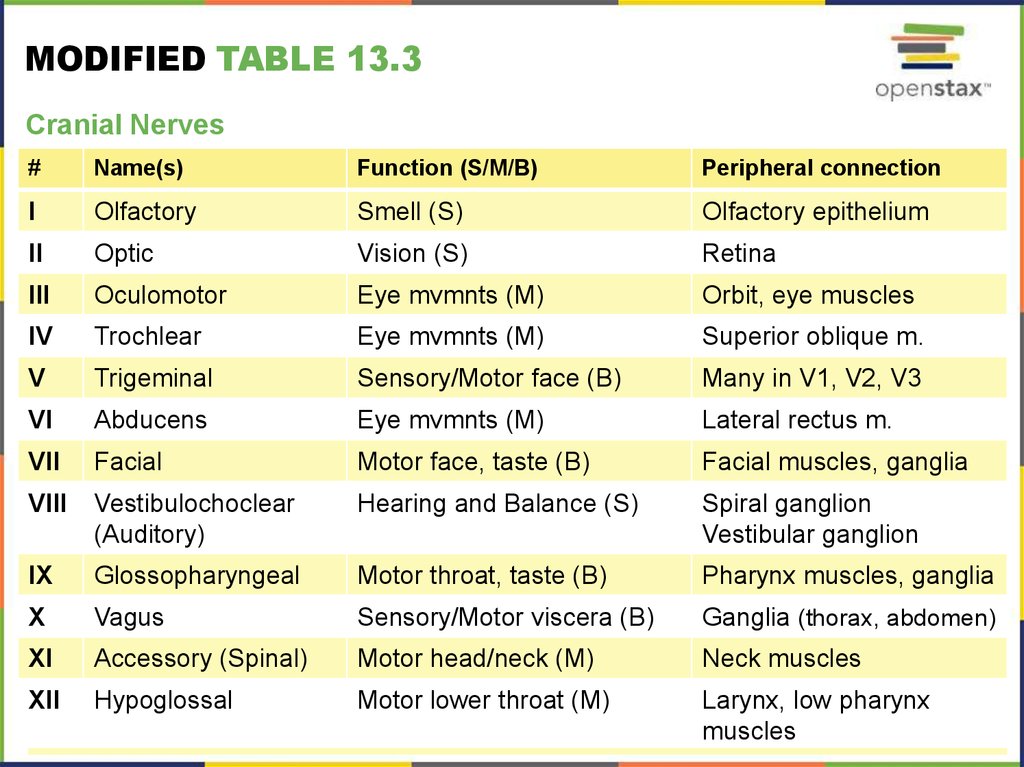




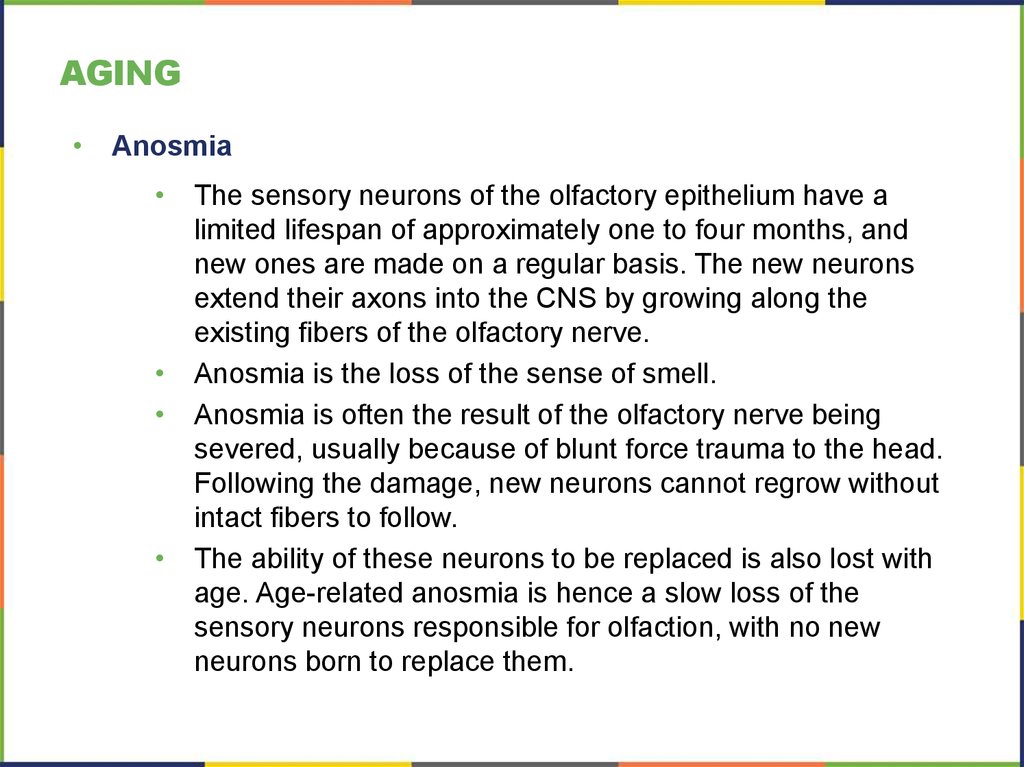

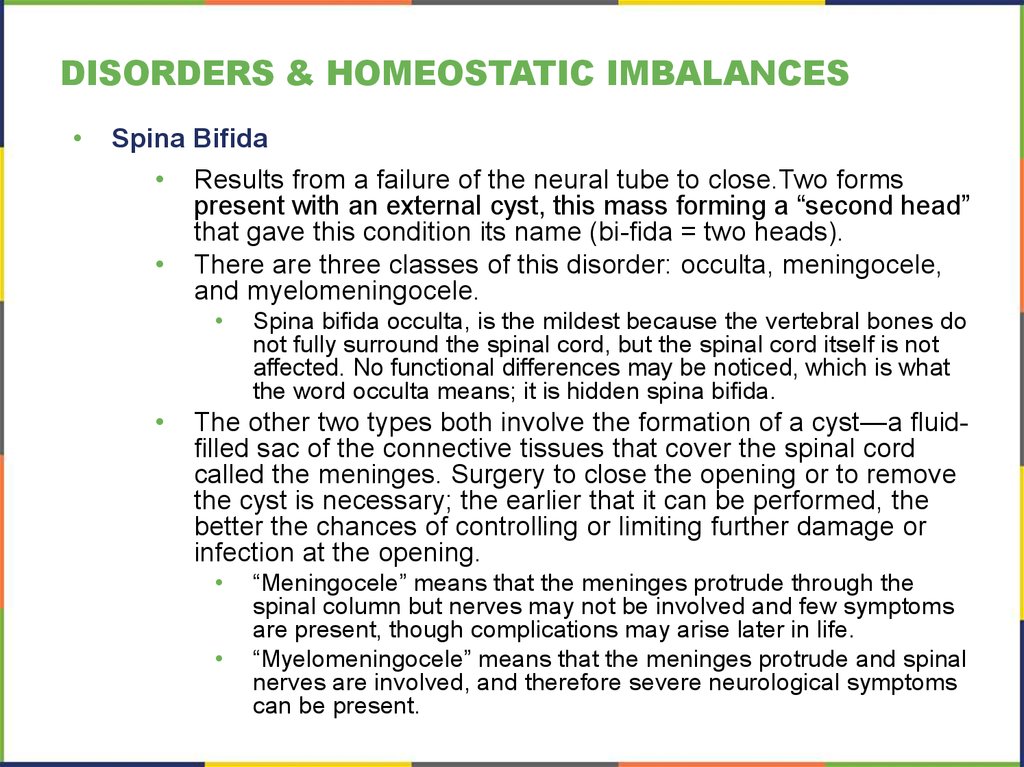


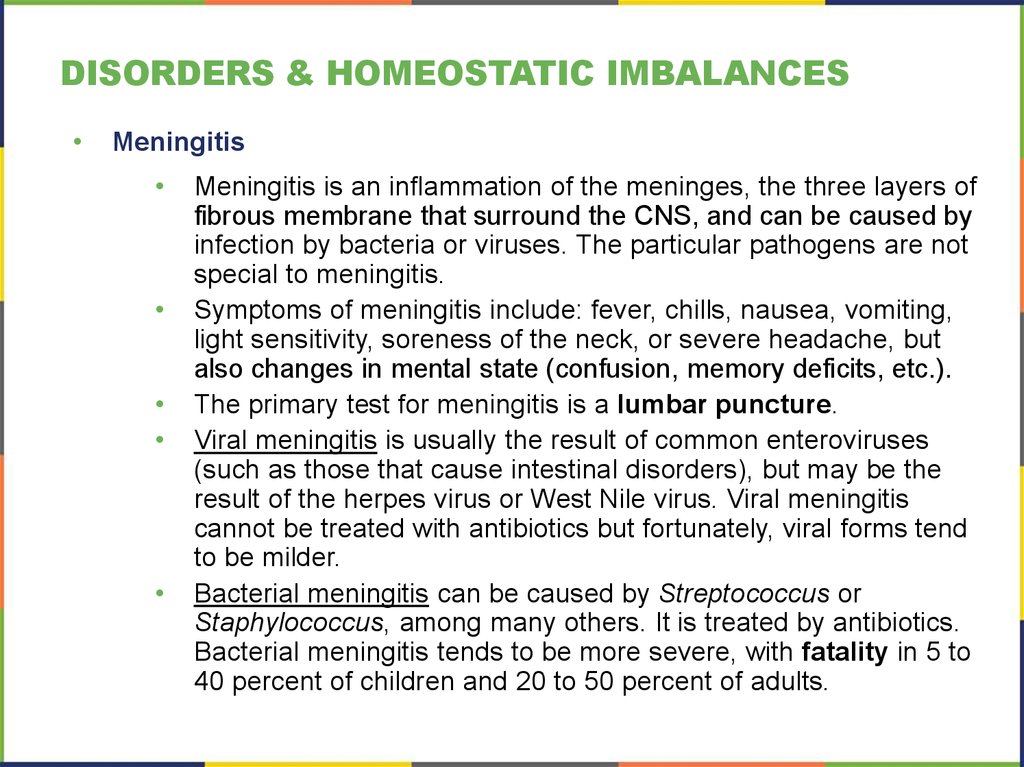
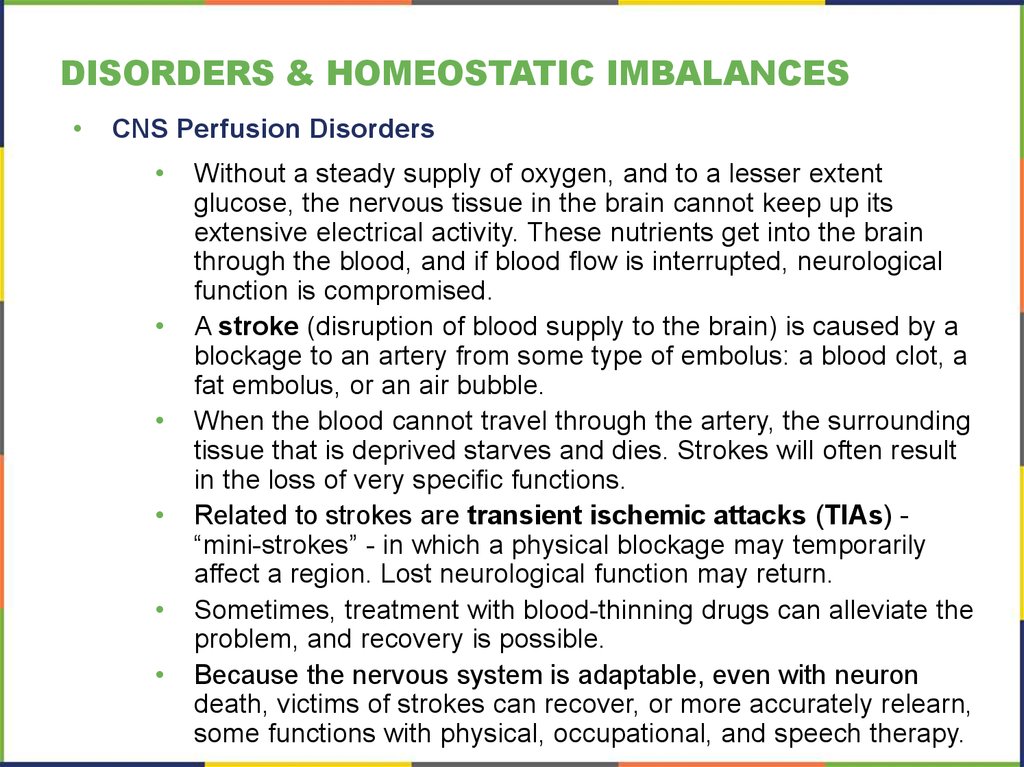

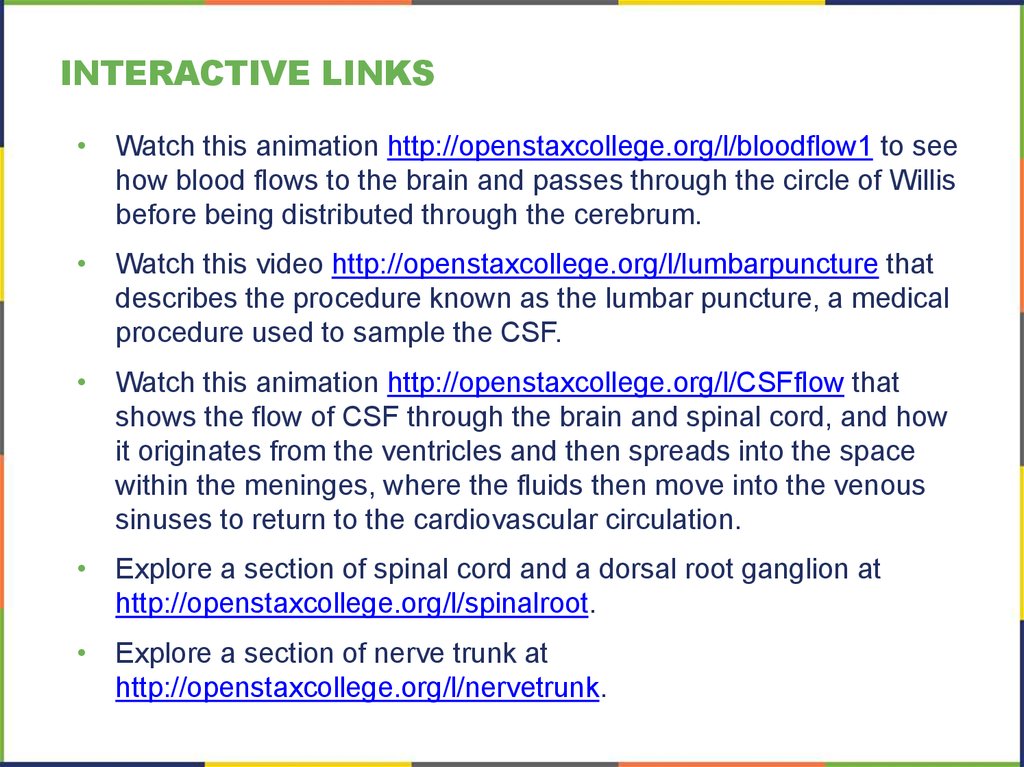


 biology
biology








